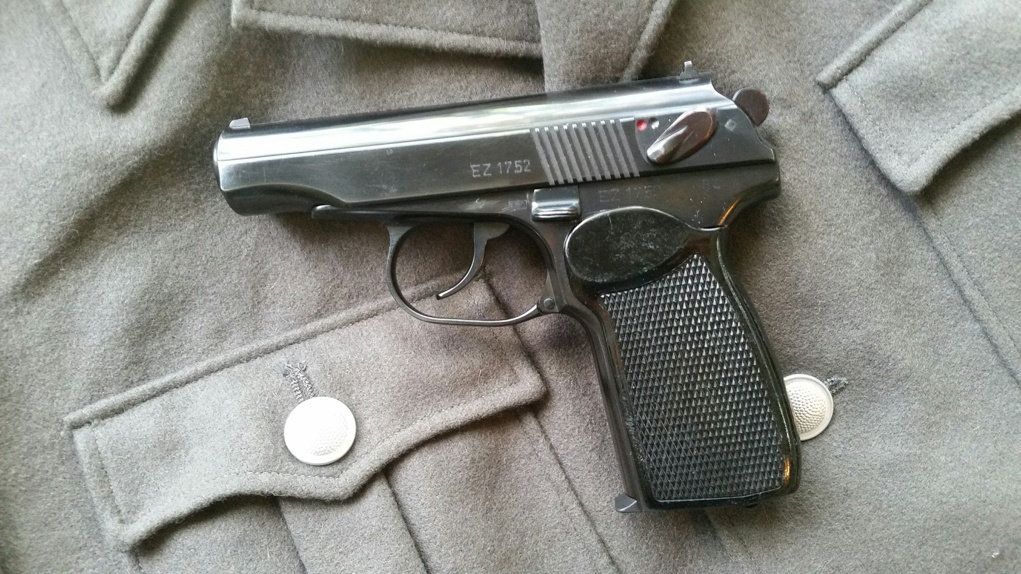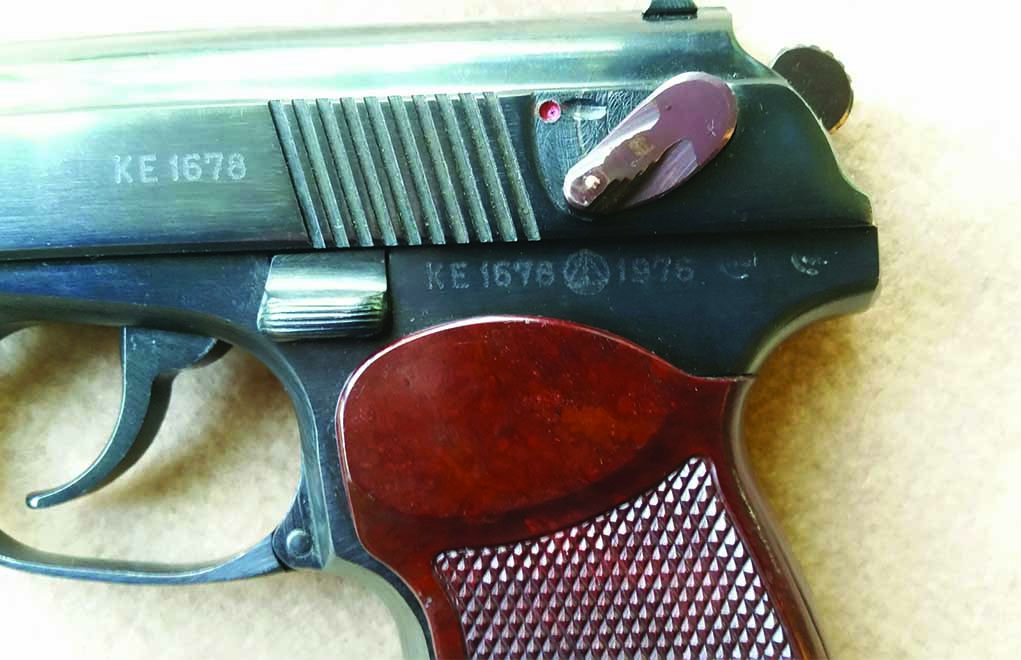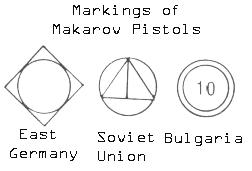- Russian Makarov Serial Numbers Free
- Bulgarian Makarov Serial Number Date
- East German Makarov Serial Numbers
Part of the Makarov pistol page. Please see makarov.com.

East German Makarov
Russian Makarov Serial Numbers Free

- 2- P64 Polish Radom Factory pistol Magazines 9X18 Makarov 6 Round Original Police serial numbers have been removed and mag was reblued afterward as shown Factory Russian Makarov 9x18 380 acp 10rd Double Stack Magazine KBI RARE.
- Makarov Pistol Serial Number Info Number. Jul 14, 2017 The Makarov 9mm is a Russian-designed double-action, straight blowback pistol. The 9x18mm Makarov cartridge is distinct from the 9mm Luger, uses an odd-sized.365-inch bullet. Russian Makarov imports lasted only a few short years due to the Clinton import ban.
By Frank Iannamico
A few short year ago the Makarov pistol was, one of the many enigmas from behind the communist iron curtain. Few people in the western world had ever seen one, or even knew they existed.
A few Makarovs had slowly made their way into the hands of U.S. collectors over the years. Some were brought to this country during the Vietnam war by returning vets. A few more were captured from the Russians during the Afghanistan war and somehow made their way into the United States. These pistols were extremely rare and expensive. The Makarov pistols in this country were only found in the gun collections of the affluent. Even the peculiar 9x18 Makarov ammo was strictly a collectors item and was as uncommon as the pistols themselves. If someone had the occasion to have Makarov ammunition and a Mak pistol, they would have been considered foolish to fire it, due to the high value of both.
Today things are quite different. Since the fall of the Berlin wall and communism in Europe, previously rare communist firearms that once commanded high “collector only” prices have become commonplace. The pistols are now inexpensive, due to the quantities imported. Even the once rare 9x18 Makarov ammunition is common today in both military surplus, and newly manufactured, commercial forms. The reloading industry was quick to respond to owners of 9x18 com bloc pistols, by manufacturing dies, projectiles, brass and reloading data for the Mak round.
Bulgarian Makarov Serial Number Date
A note of caution on Makarov and other pistols that fire the 9x18 cartridge. Often the pistols are referred to as the “9mm” Makarov caliber. Be advised that the 9x18 round is not interchangeable with the 9mm x 19 commonly referred to as the 9mm Luger or Parabellum, these rounds are too powerful for a straight blow back operated pistol like the Makarov. The case on a 9x18 Makarov is a straight wall case, not tapered like the common 9mm. Additionally, the Makarov round has a larger diameter projectile .363” compared to the smaller .355” diameter of the 9mm Parabellum. The .380 ACP cartridge is not interchangeable with the Mak round either. The Mak is actually closer to a 9.2mm caliber. The Makarov cartridge uses a 94 grain projectile that chronographed at a transonic an average of 1073 feet per second (10 round average). It should be noted that Federal sells threaded .380 replacement Makarov barrels. The subsonic .380 ammo works fine in the modified Makarov pistol.
Based heavily on the captured Walther PPK, the Makarov pistol was developed to replace the obsolete Tokarev 7.62x25 TT33 single action pistol that had been in Soviet service since 1933. The Russian Makarov was developed in the late 1940’s as a result of the efforts of Nikolay Makarov who worked at a Soviet small arms design bureau. The Makarov was adopted by the Red Army in 1951 as the 9mm Pistolet Makarov or PM.
The Makarov pistol is a conventional double action (double action first shot), blowback operated pistol. It has often been compared to the German Walther PP pistol, although its internal mechanics differ. It is unloaded weight is 25 ounces. The barrel is chrome lined for longevity and corrosion resistance. It is fixed to the frame. Barrel length is 3.8 “. The pistol is constructed of high quality, milled steel. The safety is thumb operated and locks the slide. The safety lever is very conveniently located on the left rear side of the slide. The safety is the hammer drop type (keep the muzzle pointed in a safe direction when applying this safety). Makarov magazines hold eight rounds in a single stack. Magazine release is the somewhat awkward “European Style” located at the base of the grip. Sights are adequate for a military pistol, the front is the blade type. The rear is a basic square notch. The double action trigger pull required 12 pounds of pressure, while the single action mode required 4 pounds of pull. Trigger pull was not especially smooth as per most military weapons. Two and half inch groups at 25 yards are possible by capable shooters. This accuracy potential greatly exceeds the capabilities of the Makarov’s predecessor, the TT33 Tokarev pistol.
The 9x18 Makarov cartridge is thought to be conceived as a direct result of the Russians capturing the German development plans for the experimental 9mm Ultra cartridge during WWII. The cartridges are not interchangeable however. Russian designer Boris Semin is credited with designing the slightly less powerful 9x18 Mak round. The 9mm Makarov round was first used in the select fire Stechkin machine pistol (ASP). The Steckin is much larger than the Makarov pistol, and is equipped with a removable shoulder stock. Steckins are practically non-existent as transferable, or even dealer sample machine guns.
The Makarov pistol, like most other Soviet weapons, were supplied to and copied by most communist nations. The Makarov was produced in Russia, East Germany, China and Bulgaria. A pistol very much resembling the Makarov was produced in Poland as the Polish model 64. The country of origin of any Makarov Pistol can easily be identified by the markings, or even more easily by the grips. Russian manufactured pistols are stocked with the reddish-orange plastic ones, with a star inside of a circle. Guns of East German origin are equipped with plain, black, checkered plastic. Chinese guns are black or red plastic, and have a shield with five stars inside. There have also been Chinese Makarovs grips with one star inside a circle, similar to the Russian guns, but black or gray in color.

Many sterile Makarovs were manufactured as well. These have no markings other than a serial number. Sterile guns are manufactured to conceal their country of origin, usually for political purposes. Many Maks in the sterile configuration were believed to have originated in China.
The first Makarov pistols to be imported to the U.S. in any sizable quantity were the Chinese Mak’s made by Norinco. Most of the ammunition imported, and still the most common today, was also of Chinese manufacture. These first Chinese Makarovs (Chinese type 59) were of very good quality, and had a nicely blued finish. The only thing I don’t like on these pistols is the large “Made in China by Norinco” writing on the slide. Due to import laws, “thumb rest” grips were installed to be able to import them as sporting arms. These early Chinese pistols are hard to find today. The Chinese Makarovs were also manufactured in .380 caliber a short while after importation began. These were probably made specifically for the U.S. market.
The next group of Makarovs to arrive in the U.S. were these manufactured in East These were rumored to be from the disbanded East German secret police. Regardless of where they came from, some of them were in virtually new condition, and of very high quality. Like the Chinese Makarovs, they too had aftermarket thumbrest grips installed, but usually the original black plastic grips were included along with two magazines and a holster. The best part was, they were cheap. Most of these high quality East German guns, like the early Chinese Mak’s, are all residing in collections today. Very few are still available, and are nowhere near the low selling price they once were.
The rarest group to be imported were some original Russian military Makarovs, complete with fixed sights and the red bakelite grips. These Russian guns are rumored to have been inadvertently shipped with a group of East German guns. They too were bargain priced. As you can guess these were all sold very quickly. As a bonus for collectors, both the East German and the original Russian military manufactured Makarovs are on the BATF Curio and Relics list.
The last and most common group of Makarovs are still widely available today. They too are of Russian manufacture. However, there is a difference that most collectors do not find especially desirable. That difference is an adjustable rear sight, and prolific commercial markings on the slide. These guns were manufactured specifically for the U.S. commercial market.

The adjustable rear sights, and thumb rest grips make these Mak’s more “politically correct.” Still they are excellent shooters, of good quality and bargain priced. They make great carry guns. They are available in both original 9x18 Makarov and the more common .380 caliber. There have been a few variations on these Mak’s as well. There is a wide grip, high capacity model that holds 10 rounds, and there are nickel plated models.
There is yet another Makarov variation that recently became available, and this one is of Bulgarian manufacture. These have the original style fixed rear sight, and come in only the original 9x18 caliber. They are also very good quality guns.
As expected there are many accessories available for the Makarov model pistols. One of the best are rubber grips made by Pearce. These grips give the Mak a very good “feel” in most hands, and enhance the ability to shoot the gun accurately. There are also many Makarov manuals and books available.
Another accessory available is a conversion kit to convert 9x18 caliber guns to the more common, and slightly slower .380 ACP automatic Colt pistol caliber. The same magazine is used. The conversion consists of only a barrel change. At first glance a barrel change appears easy, as the barrel is simply pinned and lightly pressed into the frame. In reality the firearm needs to be disassembled because there is simply not enough room to slide the barrel rearward enough to remove it. The disassembly is not overly difficult, but the less mechanically incline may want to enlist a qualified gunsmith to perform the task. The pin holes normally do not line up. The barrel’s feed ramp often impacts the magazine, preventing mag removal.
Any one of the aforementioned Makarov pistols would be a great addition to any collection of military arms. Recent imports, of course, are all marked by the company that imported them, as per BATF requirements. Most companies take great pains to make these markings as small and unobtrusive as possible.
Still many purist collectors look down their noses at “recent imports”. I personally feel the condition of most of these guns and their low price make them a real bargain for us shooter/collectors, who would otherwise never have the chance to own, shoot and enjoy such historic firearms.
This article first appeared in Small Arms Review V2N6 (March 1999) |
East German Makarov Serial Numbers
| SUBSCRIBER COMMENT AREA |
Comments have not been generated for this article.